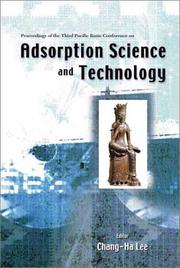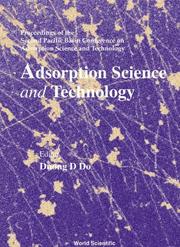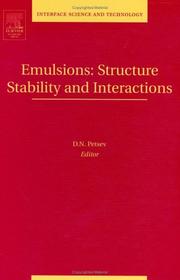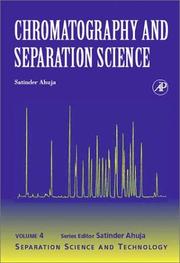| Listing 1 - 10 of 379 | << page >> |
Sort by
|
Book
Year: 2015 Publisher: Boston, MA : Elsevier,
Abstract | Keywords | Export | Availability | Bookmark
 Loading...
Loading...Choose an application
- Reference Manager
- EndNote
- RefWorks (Direct export to RefWorks)
Periodical
Abstract | Keywords | Export | Availability | Bookmark
 Loading...
Loading...Choose an application
- Reference Manager
- EndNote
- RefWorks (Direct export to RefWorks)
Book
Year: 2005 Publisher: [Place of publication not identified] : KIT Scientific Publishing,
Abstract | Keywords | Export | Availability | Bookmark
 Loading...
Loading...Choose an application
- Reference Manager
- EndNote
- RefWorks (Direct export to RefWorks)
Die Tiefenfiltration ist für all jene technischen Anwendungen ein klassisches Verfahren zur Abscheidung von Partikeln aus Fluiden, bei welchen die Partikeln nur in mäßiger Konzentration von einigen mg/m3 vorkommen oder der Druckverlust sehr gering sein soll (VDI 3677 Blatt 2). In dieser Arbeit werden Messmethoden und Modelle entwickelt, die zur zukünftigen Simulation der Filtrationskinetik von Faserfiltermedien benötigt werden.Zum einen ist es notwendig, a priori die lokale Packungsdichte in einer Filterprobe zu kennen, um spätere Simulationen und Experimente für dieselbe Probe überprüfen zu können. Dies wird mit der neu entwickelten und verifizierten Methode zur Bestimmung der lokalen Packungsdichte innerhalb einer Filterprobe, basierend auf der mit quantitativer MRI gemessenen Faserstruktur, nun möglich. Weiterhin wird die hierfür notwendige Auflösung bestimmt sowie der Einfluss der Anordnung der lokalen Packungsdichten als auch der Einfluss der Zellengröße auf die Vorhersage des Druckverlustes mittels des in der Filtertechnik üblichen Zellenmodells untersucht.Zum anderen ist ein detailliertes Verständnis der Mikrophänomene bei der Beladung einzelner Fasern notwendig, da sich die Filterperformance aufgrund der abgeschiedenen Partikeln ändert. Hierzu ist, wie die Literaturübersicht zeigt, noch wenig bekannt. Daher wurde das CFD Programm FLUENT durch User-Defined-Functions so erweitert, dass der Aufbau von Partikelstrukturen an einzelnen Fasern unter Berücksichtigung des Sperreffekts als auch des Einflusses der abgeschiedenen Partikeln auf die Strömung sowie durch Modellierung von Haften bzw. Abprallen erstmals wirklichkeitsnah durchgeführt werden kann. Es wird gezeigt, dass eine qualitativ gute Übereinstimmung der Partikelstruktur mit experimentellen Ergebnissen anderer Arbeiten erzielt wird. Die Möglichkeit der Simulation erlaubt es dann, gezielt den Einfluss der Partikelhaftung auf die Morphologie und mittleren Packungsdichte der Partikelstruktur sowie auf die Änderung von Abscheidegrad und Druckverlust mit zunehmender Anzahl abgeschiedener Partikeln zu untersuchen. In weiteren Simulationen wird für monodisperse Latex- und Kalksteinpartikeln bei kleineren Stokeszahlen ein vertieftes Verständnis der Filtrationskinetik an Einzelfasern gewonnen. In einem Ausblick wird abschließend die mögliche Anwendung der neuen Routinen zur Simulation des Clogging von Faserstrukturen aufgezeigt.
Book
ISBN: 0323951740 Year: 2024 Publisher: Cambridge, MA : Elsevier, Inc.,
Abstract | Keywords | Export | Availability | Bookmark
 Loading...
Loading...Choose an application
- Reference Manager
- EndNote
- RefWorks (Direct export to RefWorks)

ISBN: 1281906077 9786611906078 9812704329 9789812704320 9812383492 9789812383495 9781281906076 661190607X Year: 2003 Publisher: River Edge, N.J. : World Scientific,
Abstract | Keywords | Export | Availability | Bookmark
 Loading...
Loading...Choose an application
- Reference Manager
- EndNote
- RefWorks (Direct export to RefWorks)
This book presents the latest research on adsorption science and technology. It serves as an excellent reference for research in areas such as fundamentals of adsorption and ion exchange (equilibria and kinetics), new materials, adsorption characterization, novel processes, energy and environmental processes.

ISBN: 981279333X 9789812793331 9810242638 9789810242633 Year: 2000 Publisher: Singapore ; River Edge, N.J. : World Scientific,
Abstract | Keywords | Export | Availability | Bookmark
 Loading...
Loading...Choose an application
- Reference Manager
- EndNote
- RefWorks (Direct export to RefWorks)
This book presents the latest research on adsorption science and technology. It covers various aspects of materials, solid characterization, equilibria, kinetics determination and new processes.
Book
ISBN: 3110452243 311045226X 9783110452266 9783110452242 3110452170 Year: 2016 Publisher: Berlin : De Gruyter,
Abstract | Keywords | Export | Availability | Bookmark
 Loading...
Loading...Choose an application
- Reference Manager
- EndNote
- RefWorks (Direct export to RefWorks)
Chapter 1 General IntroductionDefinition of emulsions and the role of the emulsifier. Classification based on the nature of the emulsifier. Classification based on the structure of the system. General instability problems with emulsions : creaming/sedimentation, flocculation, Ostwald ripening, coalescence and phase inversion. Importance of emulsions in various industrial applications. Chapter 2 Thermodynamics of Emulsion Formation and BreakdownApplication of the second law of thermodynamics for emulsion formation : Balance of energy and entropy and non-spontaneous formation of emulsions. Breakdown of the emulsion by flocculation and coalescence in the absence of an emulsifier. Role of the emulsifier in preventing flocculation and coalescence by creating an energy barrier resulting from the repulsive energies between the droplets. Chapter 3 Interaction Forces between Emulsion DropletsVan der Waals attraction and its dependence on droplet size, Hamaker constant and separation distance between the droplets. Electrostatic repulsion resulting from the presence of electrical double layers and its dependence on surface (or zeta) potential and electrolyte concentration and valency. Combination of the van der Waals attraction with double layer repulsion and the theory of colloid stability. Steric repulsion resulting from the presence of adsorbed non-ionic surfactants and polymers. Combination of van der Waals attraction with steric repulsion and the theory of steric stabilisation. Chapter 4 Adsorption of Surfactants at the Oil/Water InterfaceThermodynamic analysis of surfactant adsorption and the Gibbs adsorption isotherm. Calculation of the amount of surfactant adsorption and area per surfactant molecule at the interface. Experimental techniques for measuring the interfacial tension. Chapter 5 Mechanism of Emulsification and the Role of the EmulsifierDescription of the factors responsible for droplet deformation and its break-up. Role of surfactant in preventing coalescence during emulsification. Definition of the Gibbs dilational elasticity and the Marangoni effect in preventing coalescence. Chapter 6 Methods of EmulsificationPipe flow, static mixers and high speed stirrers (rotor-stator mixer). Laminar and turbulent flow. Membrane emulsification. High pressure homogenisers and ultrasonic methods. Chapter 7 Selection of EmulsifiersThe hydrophilic-lipophilic-balance (HLB) and its application in surfactant selection. Calculation of HLB numbers and the effect of the nature of the oil phase. The phase inversion temperature (PIT) method for emulsifier selection. The cohesive energy ratio method for emulsifier selection. Chapter 8 Creaming/Sedimentation of Emulsions and its preventionDriving force for creaming/sedimentation: effect of gravity, droplet size and density difference between the oil and continuous phase. Calculation of the rate of creaming/sedimentation in dilute emulsions. Influence of increase of the volume fraction of the disperse phase on the rate of creaming/sedimentation. Reduction of creaming/sedimentation: Balance of the density of the two phases, reduction of droplet size and effect of addition of ''thickeners'. Chapter 9 Flocculation of Emulsions and its PreventionFactors affecting flocculation. Calculation of fast and slow flocculation rate. Definition of stability ratio and its dependence on electrolyte concentration and valency. Definition of the critical coagulation concentration and its dependence on electrolyte valency. Reduction of flocculation by enhancing the repulsive forces. Chapter 10 Ostwald Ripening and its ReductionFactors responsible for Ostwald ripening : difference in solubility between small and large droplets and the Kelvin equation. Calculation of the rate of Ostwald ripening. Reduction of Ostwald ripening by incorporation of a small amount of highly insoluble oil. Reduction of Ostwald ripening by the use of strongly adsorbed polymeric surfactant and enhancement of the Gibbs elasticity. Chapter 11 Emulsion Coalescence and its PreventionDriving force for emulsion coalescence : Thinning and disruption of the liquid film between the droplets. The concept of disjoining pressure for prevention of coalescence. Methods for reduction or elimination of coalescence : Use of mixed surfactant films, use of lamellar liquid crystalline phases and use of polymeric surfactants. Chapter 12 Phase Inversion and its PreventionDistinction between catastrophic and transient phase inversion. Influence of the disperse volume fraction and surfactant HLB number. Explanation of the factors responsible for phase inversion. Chapter 13 Characterisation of EmulsionsMeasurement of droplet size distribution : Optical microscopy and image analysis. Phase contrast and polarising microscopyDiffraction methods. Confocal laser microscopy. Back scattering methods Chapter 14 Industrial Application of Emulsions14.1 Application in Pharmacy14.2 Application in Cosmetics 14.3 Application in Agrochemicals14.4 Application in Paints14.5 Application in the Oil Industry

ISBN: 9780120884995 0120884992 9780080472652 0080472656 9786610968220 1280968222 Year: 2004 Publisher: Amsterdam : Academic Press,
Abstract | Keywords | Export | Availability | Bookmark
 Loading...
Loading...Choose an application
- Reference Manager
- EndNote
- RefWorks (Direct export to RefWorks)
Emulsion science is rapidly developing due to its practical importance and the fundamental challenges that it offers. Due to its complexity, there is still a significant lack of understanding about emulsions. With its comprehensive and rigorous approach, Emulsions: Structure, Stability and Interactions is the perfect 'stand-alone' source of information for scientists looking to obtain up-to-date knowledge about the fundamentals of emulsion science and those looking to familiarize themselves with the subject in greater detail. While each chapter presents a concise review on a specific topic, th

ISBN: 9780120449811 0120449811 9780080501123 0080501125 1281072478 9781281072474 9786611072476 6611072470 Year: 2003 Publisher: Amsterdam ; Boston : Academic Press,
Abstract | Keywords | Export | Availability | Bookmark
 Loading...
Loading...Choose an application
- Reference Manager
- EndNote
- RefWorks (Direct export to RefWorks)
The basic objectives of this book are to: provide basic information on chromatography and separation science; show how simple extraction and partition processes provide the basis for development of chromatography and separation science; describe the role of chromatography and separation science in various fields; discuss the role of chromatography and separation science in development of new methodology; and present new evolving methods and how to select an optimum method.· The book covers the fundamental physical and chemical phenomena involved in separations· Provides a concise o
Periodical
Abstract | Keywords | Export | Availability | Bookmark
 Loading...
Loading...Choose an application
- Reference Manager
- EndNote
- RefWorks (Direct export to RefWorks)
| Listing 1 - 10 of 379 | << page >> |
Sort by
|

 Search
Search Feedback
Feedback About
About Help
Help News
News